Redwoods
Joe Medeiros
Professor Emeritus, Botany, Sierra College
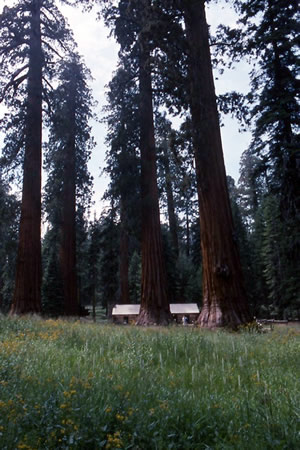
In 1937 California designated “the California Redwood” as the official state tree. Initially, the precise species was not named. Californians knew very well that they had two exceptional trees that easily qualified to be so designated: the redwood of the cool coastal forests and the giants of the Sierra Nevada.
Confusion resulted from this ambiguity until 1951 when California’s Attorney General ruled that both species qualified to fit the bill as state tree. It took until 1953 before the California Senate (Bill No. 1014) amended the 1937 title and recognized both Sequoia sempervirens (Coast redwood) and Sequoia gigantea (Giant Sequoia) as equal and official California State Trees. Adding to a list of unique species, Californians could then add two trees, the tallest and the most massive in the world, to their growing collection of state symbols.
Nature has endowed California with a rich collection of conifers (cone-bearers). The most common and diverse are the pines, of which there are eighteen species in the state. There are also ten cypresses, seven true firs, four junipers, three spruces, two “whitecedars”, two hemlocks, two Douglas-firs, and one species each of arborvitae, California-nutmeg and incense-cedar; a grand total of 52 conifer species!
Redwoods are in the Cypress Family
While our redwoods were once classified as being in their own Redwood Family (Taxodiaceae), it is now clear (thanks to sophisticated genetic techniques) that both California redwoods fall into the Cypress Family – a large family of conifers that also includes junipers and incense-cedars. Nearly 30 genera (groups) of trees exist in the cypress family around the world.
Like our incense-cedar, many of California’s “cedars” are misnamed. Our incense-cedar (like the various false-cedars of the Pacific Northwest) is a cypress. There are no true cedars (Cedrus) in the New World. All the true cedars (like Deodar, Atlas and Lebanon cedars) are native of Old World regions.
Our redwoods are now classified by botanists as belonging to the Redwood Subfamily (Sequoioideae) of the Cypress Family. Only three genera are in this Redwood Subfamily: Sequoia and Sequoiadendron in California and Metasequoia (Dawn Redwood) in China. A closely-related “redwood”, the bald cypress or swamp cedar (Taxodium distichum) exists in the swampy lowlands of our American southeastern states, but its genetics and cone structure place it in a different subfamily of the cypresses.
Our unique California redwoods come from noble ancestors around the world and still have relatives that span the globe. In fact, there are fossil forests of redwoods throughout the northern hemisphere. Today, the three remaining groups of true redwoods are restricted and reduced significantly from their historic ranges. The genus Sequoia (coast redwood) is restricted to the foggy coast of northern California and southern Oregon. The genus Sequoiadendron (giant sequoia) is found only in mid-elevation forests of the Sierra Nevada. The genus Metasequoia (dawn redwood) is limited to a small region of Lichuan in east-central China. All three redwood species are now planted ornamentally (horticultural landscape trees) throughout the world.
Coast Redwood
While we will focus our attention on the Sierran species of redwood, the giant sequoia, it’s hard not to mention its California cousin, the coast redwood. Sequoia sempervirens is naturally distributed from Monterey County in California to Curry County in southwestern Oregon. It is widely accepted as the tallest of all tree species in the world. Since it was located and measured in 2006, a tree named Hyperion has been considered the tallest, measuring in at 115.72 m (379.7 feet). Numerous other trees compete closely with this tree in height and there is always a search for a taller one!
This tree is protected in a remote area of Redwood National and State Park in northwestern California. While we can be proud of the significant human efforts that protected the remaining coast redwoods, we must also acknowledge that these protected groves represent far less than 4% of the historic distribution of California’s coastal redwood forests. Most coastal redwood forests were heavily logged.
Giant Sequoia
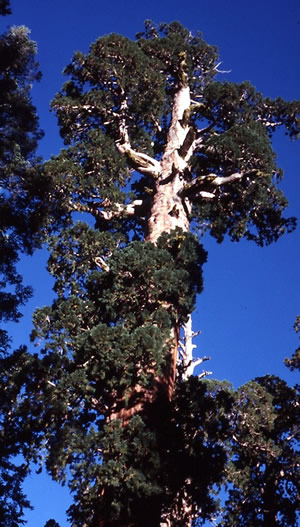 The largest (by volume) tree in the world is California’s very own and is endemic (unique) to California—it grows nowhere else naturally. While thousands of giants have been planted throughout the world—for their botanical curiosity and handsome structure—they reproduce on their own only in the Sierra Nevada. Paleontological records show that redwoods were once distributed widely around the world. Fossils of early redwood ancestors are found throughout Asia and North America. Some of the closest redwood ancestors to the “modern” giant sequoia have been found from southern Idaho and throughout the Great Basin Desert.
The largest (by volume) tree in the world is California’s very own and is endemic (unique) to California—it grows nowhere else naturally. While thousands of giants have been planted throughout the world—for their botanical curiosity and handsome structure—they reproduce on their own only in the Sierra Nevada. Paleontological records show that redwoods were once distributed widely around the world. Fossils of early redwood ancestors are found throughout Asia and North America. Some of the closest redwood ancestors to the “modern” giant sequoia have been found from southern Idaho and throughout the Great Basin Desert.
Today, for whatever reasons (we suspect climate change since the Pleistocene Ice Age), giant sequoias are restricted to approximately 67 groves (specialists disagree on exactly what constitutes a grove) from the smallest (6 trees) in Placer County to the Deer Creek Grove in the Giant Sequoia National Monument, 250 miles south. Assuming a larger distribution in the past, the extant groves now occupy mid-elevation mixed forests from roughly 4000 feet elevation in the northern Sierra to 8000 feet in the southern range. Fifty nine of the 67 giant sequoia groves lie south of the Kings River, clearly making the Southern Sierra the haunt of the largest groves and the most massive trees.
In the southern Sierra, giants are well acquainted with both snow and fire—having evolved alongside both of these naturally occurring influences.
These are trees and groves that must be seen! Far too many Californians have yet to experience giant sequoia magnitude and impressiveness. Dwight Willard’s excellent compendium (see references) provides a road map for big tree pilgrims. He laments that giants exist only on about 38,000 acres of the Sierra (compared to 2 million acres of coast redwoods) and that most giants seen by visitors are those easily viewed (from parking lot or short trails).
The most-often observed giants are in Calaveras Big Trees State Park, the Mariposa Grove in Yosemite, the Grant Grove in Kings Canyon National Park or the Giant Forest in Sequoia National Park. The magnificent giants that are seen in these parks represent only a few of the thousands of mammoths now under protection.
Nomenclature
Our Sierran redwood goes by several names: Giant sequoia, Sierra Big Tree, Big Tree and others.
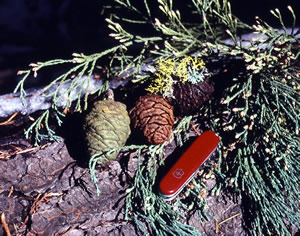
Historically it has been called arbor vitae, great tree, mammoth tree, giant tree, big tree, California big tree, Sierra redwood and probably other names (we have yet to know of the names given it by early California Indians). In a wonderful National Park Service publication written by Richard Hartesveldt and others (1975), the naming, or nomenclature of the tree illustrates the novelty of such a new and previously undocumented tree to the scientific literature. Even botanists couldn’t agree where this new species belonged. Its cones defined it as a conifer, but without typical needles (the photosynthetic tissues of the tree are scale-like) some thought it like arborvitae, a group of trees with scale-like leaves in the cypress family.
Others thought it more like the Taxodium group of flood tolerant cypresses (like America’s bald cypress and Mexico’s Tecate cypress). These were excellent considerations, but the size of this tree and its uniqueness compelled botanists of the day to name it in honor of historical figures of equal magnificence or importance. Consequently, generic names suggested included Washingtonia, Wellingtonia, Sequoia Americanus and others.
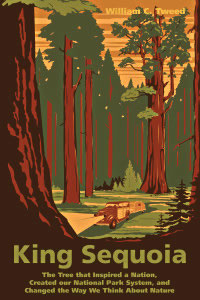
While our two California redwoods were eventually named Sequoia sempervirens and Sequoia gigantea, botanists later agreed that the giant sequoia was different enough to deserve a separate genus, that of Sequoiadendron. To properly pair the Latinized genus with the species name, the new scientific name became Sequoiadendron giganteum – as it is still regarded today.
William Tweed’s excellent book, King Sequoia (2016) clarifies this convoluted history of the naming of the giant sequoia. He also discusses, in detail, a long-held misrepresentation: that the tree was named for the American Cherokee Sequoia (Sequoyah). Dr. Tweed tried hard to find the connection between the tree and the Native American, but no such evidence turned up. It appears that the name Sequoia might be more logically connected to the Latin-derived sequi or sequor, meaning “following”; or related to some sequential aspect of the trees evolution or even the sequential spiral of the seed scales of its cones. The mystery of how Sequoia got its name evades us still!
Wawona
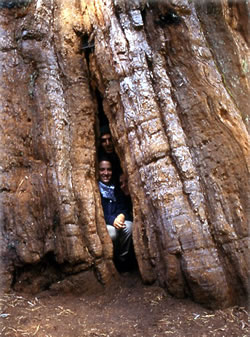
Since early humans lived among sequoia groves for millennia, it seems logical that they would have had names for the trees as well as close relationships with the giants. Perhaps, not being an apparently important source of food (tiny seeds, inedible bark and leaves, etc.) they were not given names like the oak trees with their nutritious acorns. Burnt-out boles of giants may have been utilized, when fallen, as shelter. While sequoia bark could have been used for siding of temporary structures, there was ample supply of a better material, incense-cedar bark. Consequently, perhaps native peoples had less of a utilitarian relationship with sequoia than with other trees or organisms upon which they relied. Regardless, it is hard to imagine living among these behemoths without applying a name to them.
Stephen Powers, in Tribes of California (1877) lists the term “woh-woh’nau” (or “wawona” as pronounced today). Powers records that the Mokelumne Tribe of Mi-Wuk use the word (wawona) as an imitation of the hoot of an owl, the guardian spirit and deity of the sequoia trees—and that it was considered bad luck to cut or damage the trees. Unfortunately, there is nothing else that substantiates this claim. The name Wawona lives on today as the general location of the tourist facilities nearest the Mariposa Grove of giants in Yosemite. It was also known as Big Tree Station and Clark’s Station. Wawona was also the name of the once-famous Wawona Tree or Wawona Tunnel Tree which was excavated in 1881 as a tourist attraction through which carriages and cars could be driven. It later fell, in 1969, under a heavy snow load. Wawona is now known as the Fallen Tunnel Tree.
Publications Boost Tree's Understanding
A marvelous and scholarly treatise on the ecology of the giant sequoia was done in 1975 by Richard Hartesveldt, H. Thomas Harvey, Howard Shellhammer and Ronald Stecker. The book, titled The Giant Sequoia of the Sierra Nevada was published by the National Park Service (U.S. Department of the Interior) in Washington, D.C. This archetypal publication spans from discussions of the European “discovery” of the tree, to its uniqueness, characteristics of the tree, its life history, interrelationships and the roles of fire and humans in the future of the species.
A few years later (1980), Harvey, Shellhammer and Stecker (in the absence of Hartesveldt who died unexpectedly even before the publication of the first book) drilled down into the ecology and distribution of the giants in Giant Sequoia Ecology (again, published by the National Park Service).
These two seminal publications set the stage for the botanical and ecological understanding of the world-famous trees. Collectively, they illustrated clearly that the trees were not alone—that they were part of an ecological community of many species—and that this community depended upon snow and fire.
World-wide Awe

At first “discovery” (Euro-American observations) it must have been easy to become infatuated with sequoia superlatives. They were the most massive individual creatures on Earth—many times more massive than blue whales, the largest animals. They were hundreds of feet tall but they also had huge bases—more than 30 feet in diameter only a few feet above the ground. For many of these mammoths, it would take 20 or more adults, holding hands, arms outstretched to encircle their bases. They live for thousands of years and remain reproductive throughout their entire lives. They produce tens of thousands of cones and each cone can produce hundreds of seeds. Despite this, each seed is relatively miniscule. The tiny seeds of this massive tree average less than ¼ inches in length and it takes more than 90,000 to weigh a pound; each feather-light seed weighing in at 0.00018 ounce. Put in a different way, it takes more than 200 seeds to equal the weight of a paper clip, about one gram.
Retired Sequoia National Park manager, William Tweed places our state tree in a position beyond the simple superlative. He proposes that the tree’s history transcends simple measurement by mass or magnificence. In his recent book, he elucidates their discovery by Euro-Americans, multiple and tragic slaughters of individual trees and entire groves and the rise of deeply-felt compassion for the species. He proposes, and justifiably so, that it is the Big Tree, our Sequoiadendron giganteum that unites a nation of conservationists and preservationists and becomes the iconic symbol of the world’s first systematic agency for the protection of large natural areas.
Perhaps the title of Tweed’s book tells it all: King Sequoia: The Tree that Inspired a Nation, Created our National Park System, and Changed the Way We Think About Nature. Tweed’s celebratory book was co-published by Heyday (Berkeley) and Sierra College Press (Rocklin) in 2016, the centennial of the formal establishment of the National Park Service.
Some References:
Coast Redwood
- The Wild Trees by Richard Preston / Random House 2007
- National Geographic Magazine – Redwoods / October 2009
Giant Sequoia/Big Tree
- The Giant Sequoia of the Sierra Nevada. R. Hartesveldt, et al. U.S. Department of the Interior / National Park Service. Washington, D.C. 1975.
- Giant Sequoia Ecology: Fire and Reproduction. H. T. Harvey, et al. U.S. Department of the Interior. National Park Service. Washington, D.C. 1980.
- Challenge of the Big Trees. L. Dilsaver and W. Tweed. Sequoia Natural History Association. Three Rivers, CA. 1990
- A Guide to the Sequoia Groves of California by Dwight Willard. Yosemite Association. 2000
- King Sequoia: The Tree that Inspired a Nation, Created our National Park System, and Changed the Way We Think About Nature by William Tweed. Heyday and Sierra College Press. 2016
- National Geographic Magazine – The World’s Largest Trees / December 2012
- Photos and cone drawing by author
Interesting Website
